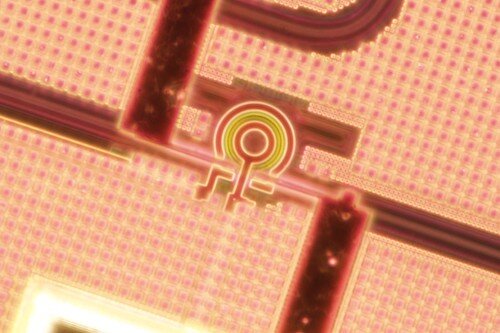A team led by researchers at the University of Bristol developed a method for operating mass manufacturable photonic sensors at the quantum limit. The work paves the way for practical applications, including the monitoring of greenhouse gas emissions and cancer detection.

A photonic chip with a micro-ring resonator nanofabricated in a commercial foundry. Courtesy of Joel Tasker/University of Bristol.
Quantum sensing has the potential to vastly expand the functionality and performance achievable by sensing technology. Quantum states of light have been shown to enhance precision in absorption estimation over classical strategies. However, the greater precision, increased speed, and better reliability at the end of the tunnel can be reached only after certain barriers are broken.
The majority of quantum sensing methods rely on special entangled or squeezed states of light or matter that are difficult to generate and detect.
A team of physicists at the University of Bristol, the University of Bath, and the University of Warwick have shown that it’s possible to perform high-precision measurements of important physical properties without the need for sophisticated quantum states of light and detection methods. The breakthrough uses ring resonators — tiny racetrack-like structures that guide light in a loop to maximize its interaction with the sample under study. And ring resonators can be mass manufactured using industry standard fabrication methods.

“We are one step closer to all integrated photonic sensors operating at the limits of detection imposed by quantum mechanics,” said Alex Belsey, a doctoral student at the University of Bristol and first author of the study.
The physicists exploited interference and resonant enhancement effects to show that coherent-state probes in all-pass ring resonators outperformed any quantum probe single-pass strategy even when normalized by the mean input photon number. The team said that, under optimal conditions, coherent-state probes equaled the performance of arbitrarily bright, pure, single-mode squeezed probes in all-pass ring resonators.
The technology’s ability to sense absorption or refractive index changes can be employed to identify and characterize a wide range of materials and biochemical samples, with topical applications ranging from environmental monitoring to disease detection.
“We are really excited by the opportunities this result enables: We now know how to use mass manufacturable processes to engineer chip-scale photonic sensors that operate at the quantum limit,” said Jonathan Matthews, associate professor at the University of Bristol and co-author of the work.
The research was published in Physical Review Letters (www.doi.org/10.1103/PhysRevLett.128.230501).